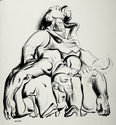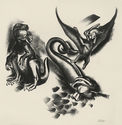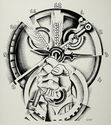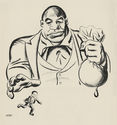
19th, 20th & 21st Century Fine Prints
707-546-7352 · fax 707-546-7924 · web: www.annexgalleries.com · email: artannex@aol.com
Hugo Gellert Biography
Hugo Gellert
American
1892–1985
Biography
Hugo Gellert, muralist, teacher, and printmaker, was born Hugó Grünbaum on 3 May 1892 in Budapest, Hungary. His family immigrated to the United States in 1907 and Hugo found at work in New York, first in a machine shop and then in a lithography shop printing movie posters. Gellert enrolled at the National Academy of Design in 1909 and also took classes at Cooper Union. As a student, he designed theater posters and stained-glass windows, the latter for Tiffany Studios. In 1914, he studied at the Académie Julian in Paris.
Soon after, Gellert rooted his personal and professional life in his leftist political convictions. He created antiwar cartoons, lithographed posters, and contributed to the Hungarian workers' paper, Elore. Magazine illustration soon became Gellert’s primary activity. In 1916 his work began to appear in The Masses, and in 1918 he joined the editorial board of The Liberator. Through membership in the American Communist party, the artist became a friend of activist leaders John Reed, Louise Bryant, and Michael Gold. After traveling to Mexico in 1919, Gellert taught art to children at the Stelton Modern School in New Jersey.
In 1928 Gellert co-founded the Anti-Horthy League, the first American antifascist group. In 1936 the artist led the famous protest against the destruction of Diego Rivera’s mural at Rockefeller Center. He was also chairman of the Artists Committee of Action, and a founding member of the American Artists Congress. From 1920 to 1923 Gellert was on the staff of Pearson’s Magazine and contributed to a score of other periodicals. He had his first one-man exhibition at the Kevorkian Gallery in New York in 1923. In 1926 Gellert became a contributing editor to The New Masses. Late in the decade, he gravitated toward mural painting, creating murals for the Workers’ Cafeteria at Union Square in 1928 and a fresco in the Center Theater at Rockefeller Center in 1932. His murals created a controversy when they were exhibited at the museum of Modern At in 1931 and 1932.
Gellert joined the National Society of Mural Painters and, in 1934, he helped form the Mural Artists Guild of the United Scenic Painters of the AFL-CIO in order to insure that wall paintings for the World’s Fair would be contracted through the union. Working in the FAP mural division in 1938, the artist painted a fresco in the Communications Building of the World’s Fair.
Hugo Gellert is represented in the collections of the Crystal Bridges Museum of American Art, Bentonville, Arkansas; the British Museum, London; the Metropolitan Museum of Art, the Museum of Modern Art, and the Whitney Museum of American Art, New York; the Philadelphia Museum of Art, Pennsylvania; the Portland Art Museum, Oregon; the Huntington, San Marino, California; the National Gallery of Art, Washington, D.C.; and the Worcester Art Museum, Massachusetts. Retrospective exhibitions of his work were held at the Marx-Lenin Institute in Moscow in 1967 and at the National Gallery in Budapest in 1968.
Hugo Gellert died on 6 December 1985 in Freehold, New Jersey.





